Documents: Go to download!
User Manual
- Owner's manual - (English, French)
- Installation Instruction - (English)
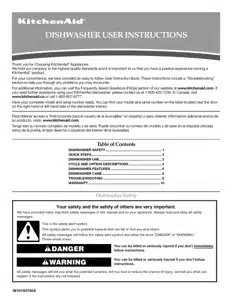
- QUICK STEPS
- CYCLE AND OPTION DESCRIPTIONS
- TROUBLESHOOTING
Table of contents
User Manual KitchenAid KUDK03CTSS3 dishwasher
QUICK STEPS
- Prepare and load dishwasher.
- Add detergent for cleaning and rinse aid for drying
- Select a cycle and option.
- Start dishwasher.
STEP 1 : Prepare and Load the Dishwasher
IMPORTANT: Remove leftover food, bones, toothpicks and other hard items from the dishes. Remove labels from containers before washing.
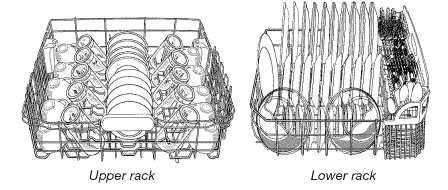
- Make sure nothing keeps spray arm(s) from spinning freely. It is important for the water spray to reach all soiled surfaces.
- Make sure that when the dishwasher door is closed no items are blocking the detergent dispenser.
- Items should be loaded with soiled surfaces facing down and inward to the spray as shown. This will improve cleaning and drying results.
- Avoid overlapping items like bowls or plates that may trap food.
- Place plastics, small plates and glasses in the upper rack. Wash only plastic items marked "dishwasher safe."
- To avoid thumping/clattering noises during operation: Load dishes so they do not touch one another. Make sure lightweight load items are secured in the racks.
- When loading silverware, always place sharp items pointing down and avoid "nesting" as shown.
STEP 2 :
Add Detergent
NOTE: If you do not plan to run a wash cycle soon, run a rinse cycle. Do not use detergent.
- Use automatic dishwasher detergent only. Add powder, liquid or tablet detergent just before starting a cycle.
- Fresh automatic dishwasher detergent results in better cleaning. Store tightly closed detergent container in a cool, dry place.

- The amount of detergent to use depends on:
- How much soil remains on the items - Heavily soiled loads require more detergent.
- The hardness of the water - If you use too little in hard water, dishes won't be clean. If you use too much in soft water, glassware will etch.
- Soft to Medium Water (0-6 grains per U.S. gallon) [typical water softener water and some city water] Medium to Hard Water (7-12 grains per U.S. gallon) [well water and some city water]
- Depending on your water hardness, fill the Main Wash section of the dispenser as shown. Fill the Pre-Wash section to the level shown, if needed.
NOTE: Fill amounts shown are for standard powdered detergent. Follow instructions on the package when using other dishwasher detergent.
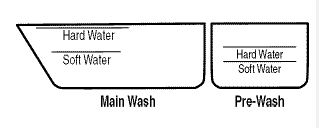
Add Rinse Aid
- Your dishwasher is designed to use rinse aid for good drying performance. Without rinse aid your dishes and dishwasher interior will have excessive moisture. The heat dry option will not perform as well without rinse aid.
- Rinse aid keeps water from forming droplets that can dry as spots or streaks. They also improve drying by allowing water to drain off of the dishes after the final rinse.
- Rinse aid helps to reduce excess moisture on the dish racks and interior of your dishwasher.
- Check the rinse aid indicator. Add rinse aid when indicator drops to "Add" level.
- To add rinse aid, turn the dispenser cap to "Refill" and lift off. Pour rinse aid into the opening until the indicator level is at "Full." Replace the dispenser cap and turn to "Lock." Make sure cap is fully locked.
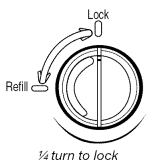
NOTE: For most water conditions, the factory setting of 2 will give good results. If you have hard water or notice rings or spots, try a higher setting. Turn the arrow adjuster inside the dispenser by either using your fingers or inserting a flat-blade screwdriver into the center of the arrow and turning.
STEP 3 : Select a Cycle (cycles vary by model)
See "Cycle and Option Descriptions" charts in the following section.
Heavier cycles and options affect cycle length. Some cycles and options will take up to 31/2hours to complete.

Select Options (options vary by model)
See "Cycle and Option Descriptions" charts in the following section.
You can customize your cycles by pressing the options desired.

STEP 4 : Start or Resume a Cycle
- Run hot water at the sink nearest your dishwasher until the water is hot. Turn off water.
- Push door firmly closed. The door latches automatically. Select the wash cycle and options desired OR press START/RESUME to repeat the same cycle and options as in the previous wash cycle.
- You can add an item anytime before the main wash starts. Open the door slowly and add the item. Close the door firmly. Press START/RESUME.
CYCLE AND OPTION DESCRIPTIONS

This information covers several different models. Your dishwasher may not have all the cycles and options described.

You can customize your cycle by selecting an option.
See option selections. If you change your mind, press the option again to turn off the option, or select a different option. You can change an option anytime before the selected option begins.
*Maximum wash times depend on water temperature, heavy soil condition, dish load size and options selected.
OPTION SELECTIONS

IMPORTANT: The sensor in your dishwasher monitors the soil level. Cycle time and/or water usage can vary as the sensor adjusts the cycle for the best wash performance. If the incoming water is less than the recommended temperature or food soils are heavy, the cycle will automatically compensate by adding time, heat and water as needed.
CONTROLS AND CYCLE STATUS
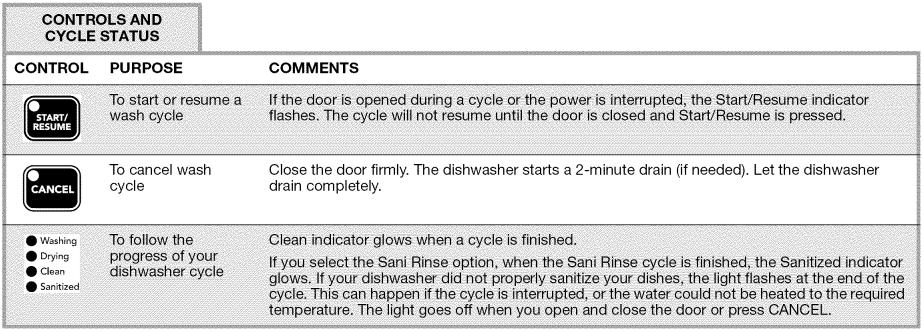
TROUBLESHOOTING
Dishwasher is not operating properly
1. Dishwasher does not run or stops during a cycle
-
Is the door closed tightly and latched?
- Is the right cycle selected?
- Is there power to the dishwasher? Has a household fuse blown, or has a circuit breaker tripped? Replace the fuse or reset the circuit breaker. If the problem continues, call an electrician.
- Has the motor stopped due to an overload? The motor automatically resets itself within a few minutes. If it does not restart, call for service.
- Is the water shutoff valve (if installed) turned on? It is normal for certain cycles to repeatedly pause for several seconds during the main wash.
2. Clean light is flashing
- Call for service.
3. Dishwasher will not fill
- Is the overfill protection float able to move up and down freely? Press down to release.
4. Dishwasher seems to run too long
The dishwasher can run up to 3 1/2 hours depending on soil level, water temperature, cycles and options.
Is the water supplied to the dishwasher hot enough? The dishwasher runs longer while heating water.
Is the dishwasher cycle time within the cycle times? See cycle sections wash times. A delay automatically occurs in some wash and rinse cycles until the water reaches the proper temperature.
This dishwasher is equipped with an optical sensor wash that detects water temperature, soil and detergent amount. Wash cycles are adjusted based on what is sensed.
IMPORTANT: The very first wash cycle after installation in your home will be adjusted to include an additional 2 rinses. This cycle must not be interrupted for proper sensor adjustment. If this adjustment cycle is canceled or stopped before the Clean light comes on at the end of the cycle, the next wash cycle will repeat this sensor adjustment.
5. Water remains in the dishwasher
- Is the cycle complete?
6. Detergent remains in the covered section of the dispenser
- Is the cycle complete?
- Is the detergent lump-free? Replace detergent if necessary.
- Is the dispenser door blocked by dishes or cookware when the dishwasher door is closed?
7. White residue on the front of the access panel
- Was too much detergent used?
- Is the brand of detergent making excess foam? Try a different brand to reduce foaming and eliminate buildup.
8. Odor in the dishwasher
- Are dishes washed only every 2 or 3 days? Run a rinse cycle once or twice a day until you have a full load.
- Does the dishwasher have a new plastic smell? Run a vinegar rinse as described in "Dishwasher Care."
9. Condensation on the kitchen counter (built-in models)
- Is the dishwasher aligned with the countertop? Moisture from the vent in the dishwasher console can form on the counter. Refer to the Installation Instructions for more information.
Dishes do not dry completely
1. Dishes do not dry completely
- Did you use a rinse aid? Your dishwasher is designed to use rinse aid for good drying performance. Without rinse aid your dishes and dishwasher interior will have excessive moisture. The heat dry option will not perform as well without rinse aid.
2. Dishes are not dry
- Did you load your dishwasher to allow proper water drainage? Do not overload. Use a liquid rinse aid to speed drying.
- Are the plastics wet? Plastics often need towel drying.
- Is the rinse aid dispenser empty?
- Did you use an air-dry or energy-saving dry option? Use a heated drying option for dryer dishes.
3. Excess moisture on racks and dishwasher interior
- Check the rinse aid indicator to see that there is rinse aid in the dispenser.
Spots and stains on dishes
1. Spotting and filming on dishes
Is your water hard, or is there a high mineral content in your water? Conditioning the final rinse water with a liquid rinse aid helps eliminate spotting and filming. Keep the rinse aid dispenser filled. Always use a high-temp option. If your water hardness is 13 grains or above, it is strongly recommended that you install a home water softener. If you do not wish to drink softened water, have the softener installed onto your hot water supply.
Is the water temperature too low? For best dishwashing results, water should be 120°F (49°C) as it enters the dishwasher.
Did you use the correct amount of effective detergent? Use recommended dishwasher detergents only. Do not use less than 1 tbs (15 g) per load. Detergent must be fresh to be effective. Heavy soil and/or hard water generally require extra detergent.
Is the home water pressure high enough for proper dishwasher filling? Home water pressure should be 20 to 120 psi (138 to 828 kPa) for proper dishwasher fill. If you have questions about your water pressure, call a licensed, qualified plumber.
NOTE: To remove spots and film from glassware, remove all silverware and metal items and run a vinegar rinse as described in "Dishwasher Care."
2. Silica film or etching (silica film is a milky, rainbow-colored deposit; etching is a cloudy film)
Sometimes there is a water/chemical reaction with certain types of glassware. This is usually caused by some combination of soft or softened water, alkaline washing solutions, insufficient rinsing, overloading the dishwasher, and the heat of drying. It might not be possible to avoid the problem, except by hand washing.
To slow this process use a minimum amount of detergent but not less than 1 tbs (15 g) per load. Use a liquid rinse aid and underload the dishwasher to allow thorough rinsing. Silica film and etching are permanent and cannot be removed. Do not use heated drying.
3. White spots on cookware with nonstick finish
Has the dishwasher detergent removed cookware seasoning? Reseason cookware after washing it in the dishwasher.
4. Brown stains on dishes and dishwasher interior
Does your water have high iron content? Rewash dishes using 1-3 tsp (5-15 mL) of citric acid crystals added to the covered section of the detergent dispenser. Do not use detergent. Follow with a Normal wash cycle with detergent. If treatment is needed more often than every other month, the installation of an iron removal unit is suggested.
5. Black or gray marks on dishes
Are aluminum items rubbing dishes during washing? Disposable aluminum items can break down in the dishwasher and cause marking. Hand wash these items. Remove aluminum markings by using a mild abrasive cleaner.
6. Orange stains on plastic dishes or dishwasher interior
Are large amounts of tomato-based foods on dishes placed in the dishwasher? It may be necessary to use a stain removal product to remove stains from your dishwasher. Stains will not affect dishwasher performance.
Noises
Grinding, grating, crunching or buzzing sounds
A hard object has entered the wash module (on some models). When the object is ground up, the sound should stop. If the noise persists after a complete cycle, call for service.
Dishes are not completely clean
Food soil left on the dishes
- Is the dishwasher loaded correctly?
- Did you choose the cycle that describes the most difficult soil in your dishwasher? If you have some items with heavier soils, use a heavier cycle.
- Is the water temperature too low? For best dishwashing results, water should be 120°F (49°C) as it enters the dishwasher.
- Did you use the correct amount of fresh detergent? Use recommended dishwasher detergents only. Do not use less than 1 tbs (15 g) per load. Detergent must be fresh to be effective. Heavy soil and/or hard water generally require extra detergent.
- Is detergent caked in dispenser? Use fresh detergent only. Do not allow detergent to sit for several hours in a wet dispenser. Clean dispenser when caked detergent is present. Is the pump or spray arm clogged by labels from bottles and cans?
- Is the home water pressure high enough for proper dishwasher filling? Home water pressure should be 20 to 120 psi (138 to 828 kPa) for proper dishwasher fill. If you have questions about your water pressure, call a licensed, qualified plumber.
- Are high suds slowing the wash arm? Do not use soap or laundry detergents. Use recommended dishwasher detergents only.
Dishes are damaged during a cycle
Chipping of dishes
Did you load the dishwasher properly? Load the dishes and glasses so they are stable and do not strike together from washing action. Minimize chipping by moving the rack in and out slowly.
NOTE: Antiques, feather-edged crystal, and similar types of china and glassware might be too delicate for automatic dishwashing. Wash by hand.
See other models: KSSP42QTS02 KMHC319ESS3 YKSEB900ESS3 KSCS23FTSS01 KDFE104DSS4
